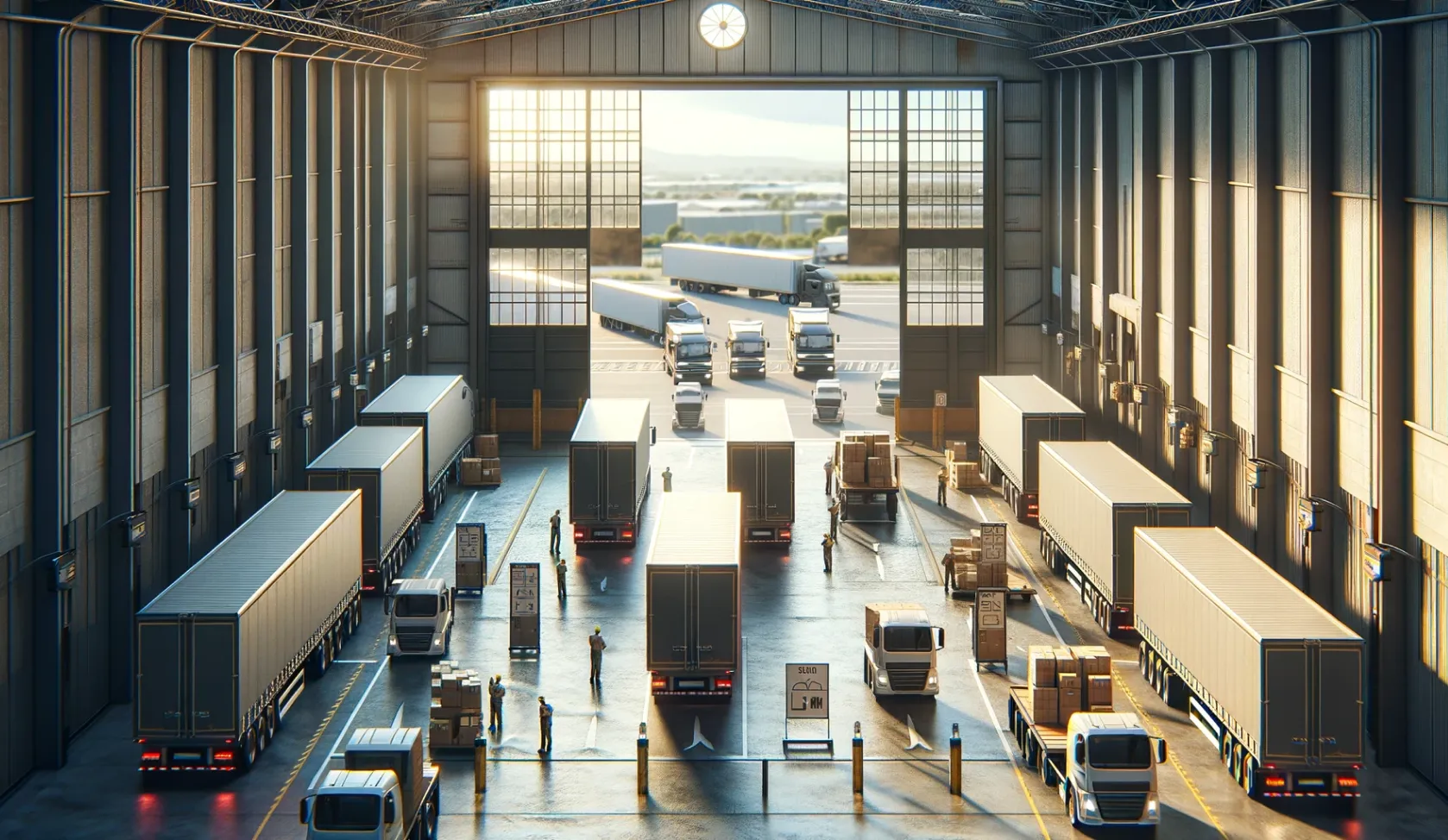Warehouses are a crucial link in every organization’s supply chain. Using large, secure, and specially designed buildings to store goods safely goes back centuries. From the ancient granaries of Egypt to the smart shipping warehouses of the 21st century, these facilities have always been indispensable in the movement of goods.
Today, the continual digitization of the modern age has forced the concept of warehouse operations to evolve. Businesses use the latest technology, such as warehouse management software (WMS) and automated robots, to increase warehouse efficiency and automation.
Whether operating through traditional means or running on smart systems, shipping warehouses play a key role in logistics.
What is a shipping warehouse?
The demand for reliable, cost-effective storage solutions continues to increase worldwide, fueled by the growing popularity of e-commerce. In 2023, there were an estimated 167,610 warehouses in operation worldwide. By 2025, that number is projected to reach 180,000.
But while demand continues to rise, the amount of space available continues to shrink. A report from February 2023 showed that there has been a steady downward trend in the amount of ready-to-occupy warehouse space in the US market from 2016 to 2022.
With high demand and low supply, different warehouses cater to different business needs. Shipping warehouses provide some of the most comprehensive storage solutions by handling every aspect, from storage, receiving, and sorting to packing and shipping from one facility.
Shipping warehouses serve as the central hub of distribution networks. They are often located close to ports, airports, and other transportation gateways to make receiving inbound shipments easier. Modern warehouses are run with advanced WMS, modern equipment, and a high degree of automation.
Since shipping warehouses are used to dispatch orders to customers, they are also sometimes called fulfillment warehouses. Although the terms are sometimes used interchangeably, shipping and fulfillment warehouses serve different functions.
Shipping warehouse vs fulfillment center
Though both are used in order fulfillment, there is a clear distinction between shipping warehouses and fulfillment centers. While both serve as storage facilities, each has different logistical purposes. The critical differences between shipping warehouses and fulfillment centers are as follows:
- Shipping warehouses are meant for medium- to long-term storage, while fulfillment centers are designed for short-term storage.
- Shipping warehouses are designed to store inventory, and fulfillment centers are created to process customer orders quickly.
- Shipping warehouses have scheduled pick-ups at certain intervals, but fulfillment centers might have several order pick-ups on the same day.
With the distinction between these two storage facilities made clear, the next topic is the various kinds of shipping warehouses that businesses can use as storage solutions.
Six different types of warehouses
Companies seeking storage space for their inventory can choose from various options. There are various types of warehouses, and each one functions in a distinct way that makes it a good fit for certain kinds of products and businesses.
There are six main types of warehouses businesses can use to store goods:
1. Public warehouse
One of the most cost-effective shipping options is a public warehouse. This is a government-owned facility where individuals and private companies can rent storage space for their items.
The biggest benefit of using public warehouses is that they offer some of the most affordable rates, which makes up for their lack of modern equipment or technology.
2. Private warehouse
Many companies and private organizations build and maintain their warehouses. These are privately owned and most commonly used to store the proprietor’s goods.
However, it is common for these warehouse owners to rent out extra storage space to paying members of the public. Because they are funded by private capital, most private warehouses are equipped with the latest technology and can easily provide holistic logistics solutions for customers.
3. Cooperative warehouse
When ownership of a warehouse is divided among a collective rather than a single entity, it is called a cooperative warehouse. Members of the collective are free to use the warehouse facilities at a special discounted rate.
A prime example would be a local farmers’ collective co-owning a warehouse to store their crops. Non-members could also use the space in a cooperative warehouse for a higher rate.
4. Bonded/Duty-free warehouse
Companies must choose their warehouse type based on the nature of their inventory. A bonded or duty-free warehouse is best if a business deals primarily in imported goods. These storage facilities are approved by customs authorities to store goods from overseas without paying duties and taxes.
To maximize efficiency and minimize cost, many businesses use bonded shipping warehouses to keep their inventory right until the moment of dispatch.
5. Consolidation warehouse
Some businesses don’t move inventory at large enough volumes to warrant using an entire warehouse. These organizations and individuals can use consolidation warehouses to store goods before shipping. These warehouses gather multiple small shipments until there are enough to fill a container bound for one location.
Companies can reduce their shipping costs by splitting container fees at consolidated warehouses.
6. Smart warehouse
A smart warehouse is the most modern iteration in terms of structure and internal processes. They represent the current pinnacle of logistics technology, combining WMS, robotics, the Internet of Things (IoT), autonomous guided vehicles (AGVs), and other cutting-edge technology to achieve higher levels of efficiency in storage, package handling, and order fulfillment.
Why smart warehouses are the future of shipping operations
Smart warehouses are going to redefine the industry in the coming years. The rate of technology adoption in warehouses is steadily increasing, and by 2027, the warehouse automation market is projected to reach a global value of $41 billion.
Transforming traditional shipping warehouses into smarter versions via automation and robotics, allows these warehouses to function as more than mere storage facilities. Smart warehouses create a data-driven logistics environment where key metrics can be tracked to gain valuable insights that add business value.
When leveraged correctly, smart warehouses boost efficiency, reduce costs, and afford greater visibility over an organization’s inventory.
Understanding the warehouse shipping process
Traditionally, the main function of a warehouse is to store goods. Shipping warehouses have additional functions, the most important of which is sending packages out for delivery. This is a multi-stage process that unfolds in several stages.
Four stages of warehouse shipping
There are four distinct processes that every shipping warehouse must complete to successfully deliver a customer’s order. Even before an order is placed, an efficient system to receive goods must be in place, with accurate data about the number of items currently available. This information can be gathered using WMS.
Once this data is ready, the shipping warehouse is ready to accept orders and fulfill them.
- Receiving: The first stage is receiving the customer’s order. All orders are automatically logged into the warehouse management system to confirm that the items are available.
- Processing: After an order is received by the warehouse, it proceeds to the processing stage. Order processing involves cross-checking customer information and verifying the delivery address to ensure the following steps go smoothly.
- Fulfillment: Order fulfillment is the penultimate stage. In traditional warehouses, employees get the product from the floor, bring it to the packing area, and prepare it for delivery. In smart warehouses, these actions are performed by robots, AGVs, and automatic conveyor belts.
- Shipping: Once the items have been securely packed, the final step is to prepare the shipping label and attach it to the package. Next, it will be placed in an outbound shipment vehicle and sent out for delivery to the customer.
Shipping challenges and how to overcome them
Even with the adoption of cutting-edge smart warehouse technology, shipping remains complicated to pull off without expert help. Many organizations rely on third-party logistics (3PL) companies to optimize their warehousing and shipping operations.
Here are a few of the problems faced by shipping warehouses:
- Inventory shortages
- Storage and retrieval issues
- High operational costs
- Inefficient use of warehouse space
- Human error
- Health and safety hazards
Thankfully, there are workable solutions for most, if not all, of these shipping warehouse problems. A robust WMS, a flexible supply chain, and a data-driven approach to logistics can help businesses overcome any complications at their shipping warehouse.
A WMS that works for every business
The most efficient way for a business to optimize its shipping warehouse’s performance is to choose a robust and comprehensive WMS.
PackageX has a 360-degree solution for companies that operate warehouses. The PackageX WMS is scalable according to the needs of THE business and is designed to be easy for all employees to use. From receiving operations, inventory tracking, and management, to order fulfillment, PackageX delivers a comprehensive solution to instantly improve efficiency.
Increasing efficiency, productivity, and visibility in shipping warehouse logistics operations gives companies a clear competitive advantage. PackageX creates a superior experience for sellers and customers by eliminating the uncertainties involved with warehouse operations.
Read more about how this solution adds value for businesses on the PackageX website




